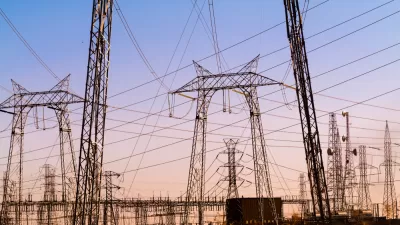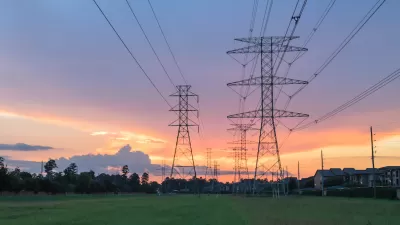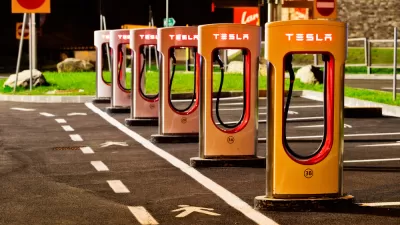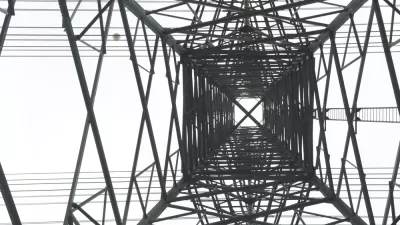The U.S. has entered a new power paradigm according to a new energy analysis that warns of unprecedented new demands for power, largely from “new manufacturing, industrial, and data center facilities,” and the grid is not prepared for the surge.

In 2016, transportation overtook power generation as the largest source of greenhouse gas emissions in the U.S. “For the first time since 1979, America’s cars, trucks, and airplanes emit more carbon dioxide than its power plants do,” reported Brad Plumer for Vox in a post on Planetizen on June 14, 2016.
[According to a fast fact from the U.S. Department of Energy's Vehicle Technologies Office, the exact date was October 24, 2016].
If current trends continue, it appears conceivable that power generation may retake its place as the largest source of the nation's greenhouse gas emissions, according to an energy analysis released in December 2023.
[Utility Dive was one of the first media outlets to cover the report: “US electricity load growth forecast jumps 81% led by data centers, industry: Grid Strategies,” December 13, 2023.]
Plumer, now with The New York Times, and Nadja Popovich, reported on the study on March 14 in the source article.
Over the past year, electric utilities have nearly doubled their forecasts of how much additional power they’ll need by 2028 as they confront an unexpected explosion in the number of data centers, an abrupt resurgence in manufacturing driven by new federal laws, and millions of electric vehicles being plugged in.
Many power companies were already struggling to keep the lights on, especially during extreme weather, and say the strain on grids will only increase. Peak demand in the summer is projected to grow by 38,000 megawatts nationwide in the next five years, according to an analysis [pdf] by the consulting firm Grid Strategies, which is like adding another California to the grid.
- Related post: Video: Can US Power Grid Handle AI’s Growing Energy Needs? March 14, 2024.
- Also by Plumer and Popovich: “Why the U.S. Electric Grid Isn’t Ready for the Energy Transition,” June 12, 2023.
The state that gets it right
“So far, one state that has kept pace with explosive demand is Texas, where electricity use has risen 29 percent over the past decade, partly driven by things like bitcoin mining, liquefied natural gas terminals and the electrification of oil fields,” report Popovich and Plumer.
Texas’s streamlined permitting process allows wind, solar and battery projects to get built and connected faster than almost anywhere else, and the state zoomed past California last year to lead the nation in large-scale solar power.
Energy experts are sounding the alarm
“The numbers we’re seeing are pretty crazy,” said Daniel Brooks, vice president of integrated grid and energy systems at the Electric Power Research Institute, a nonprofit organization.
“I can’t recall the last time I was so alarmed about the country’s energy trajectory,” said Tyler H. Norris, a former solar developer and expert in power systems who is now pursuing a doctorate at Duke University. If a wave of new gas-fired plants gets approved by state regulators, he said, “it is game over for the Biden administration’s 2035 decarbonization goal.”
“The main drivers are investment in new manufacturing, industrial, and data center facilities,” states the executive summary (pg. 3 of 29) in the report [pdf] published December 2023, adding, “The U.S. electric grid is not prepared for significant load growth.”
Economic and environmental challenges
“It’s worrisome that a resurgent American manufacturing sector may face headwinds from the limited ability of the nation’s electricity systems to respond," write Grid Strategy researchers John D. Wilson and Zach Zimmerman.
There are real risks that some regions may miss out on economic development opportunities because the grid can’t keep up.
Evan Halper also reported on the new energy projections for The Washington Post on March 7, noting that “soaring power consumption is delaying coal plant closures in Kansas, Nebraska, Wisconsin and South Carolina.”
Hat tip to Brian Yanity.
FULL STORY: A New Surge in Power Use Is Threatening U.S. Climate Goals

Maui's Vacation Rental Debate Turns Ugly
Verbal attacks, misinformation campaigns and fistfights plague a high-stakes debate to convert thousands of vacation rentals into long-term housing.

Planetizen Federal Action Tracker
A weekly monitor of how Trump’s orders and actions are impacting planners and planning in America.

Chicago’s Ghost Rails
Just beneath the surface of the modern city lie the remnants of its expansive early 20th-century streetcar system.

Bend, Oregon Zoning Reforms Prioritize Small-Scale Housing
The city altered its zoning code to allow multi-family housing and eliminated parking mandates citywide.

Amtrak Cutting Jobs, Funding to High-Speed Rail
The agency plans to cut 10 percent of its workforce and has confirmed it will not fund new high-speed rail projects.

LA Denies Basic Services to Unhoused Residents
The city has repeatedly failed to respond to requests for trash pickup at encampment sites, and eliminated a program that provided mobile showers and toilets.
Urban Design for Planners 1: Software Tools
This six-course series explores essential urban design concepts using open source software and equips planners with the tools they need to participate fully in the urban design process.
Planning for Universal Design
Learn the tools for implementing Universal Design in planning regulations.
planning NEXT
Appalachian Highlands Housing Partners
Mpact (founded as Rail~Volution)
City of Camden Redevelopment Agency
City of Astoria
City of Portland
City of Laramie





























